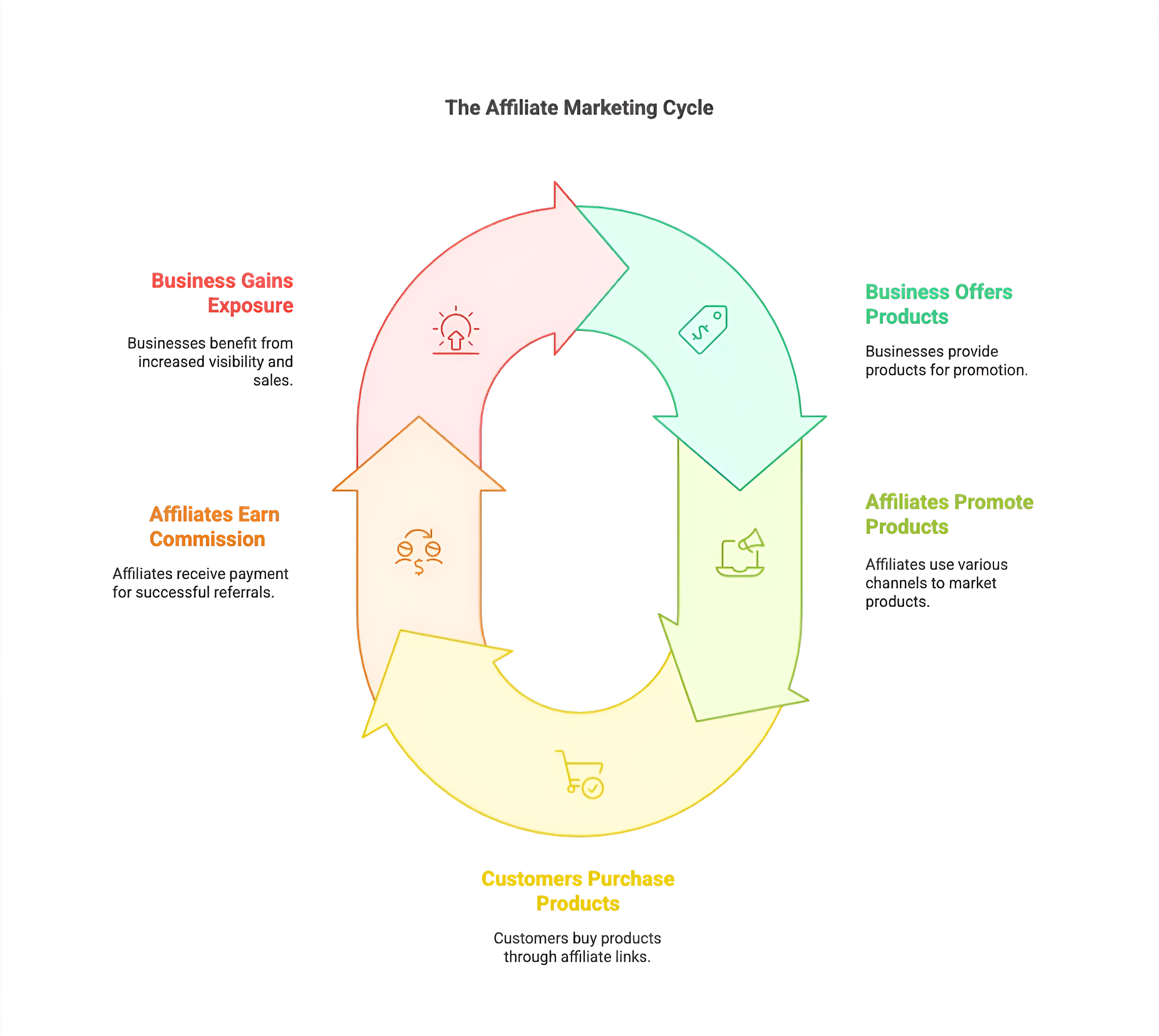How Does Affiliate Marketing Work: Pulling Back the Curtain
Tired of chasing online income strategies that overpromise and underdeliver?
Many people dream of making money online, but end up stuck in confusing systems that require huge investments and deliver little in return. That’s where affiliate marketing stands out. It’s a simple, low-risk model that actually rewards results.
If you’ve ever wondered how does affiliate marketing work, the answer is refreshingly straightforward: instead of creating your own products, you promote someone else’s and earn a commission whenever someone makes a purchase through your referral.
It’s performance-based, beginner-friendly, and scalable — and in this guide, you’ll learn exactly how affiliate marketing works and how you can start using it to generate income today.
My Perspective on Being New to Affiliate Marketing
Over the years, having explored various ways to generate income by looking into things like remote jobs, dropshipping, and surveys, affiliate marketing stands out as an stress-free, achievable method.
💡Tip: Affiliate Marketing is a long-term commitment that requires a strong work ethic. Consistently, persistence, and tons of patience will bring you success.
It enables us to work closely with businesses, helping to boost sales while earning money based on performance. By sharing products I trust, I receive commissions that support my lifestyle and help companies expand their reach.
Companies with a well-promoted brand have more opportunities to make sales. Affiliates earn money as the companies earn money, creating a mutually beneficial situation. It’s a “Win-Win!”
What Is Affiliate Marketing?
There are many types of affiliates, including bloggers, video creators, and social media influencers, who use unique platforms to market products.
Many bloggers produce in-depth reviews and guides to help consumers make informed decisions, while video creators share personal experiences in a genuine, relatable way.
This diversity makes the affiliate marketing environment dynamic and beneficial for everyone involved.

How Affiliate Marketing Works
The process behind affiliate marketing is straightforward. Four primary roles contribute to its success:
- the affiliate
- the merchant
- the affiliate network
- the customer
Every part holds the others up, and together they all grow stronger.
- The affiliate is often a blog owner or social media influencer. They act as the promoter. Their main goal is to connect potential customers with products or services they trust. This is where knowing your audience should come into focus.
- The merchant, on the other hand, is the creator or seller of the product. When merchants team up with the right affiliates, they can reach a larger audience and improve sales performance.
- An affiliate network serves as a middleman by linking affiliates with merchants through tracking tools that manage referrals and payments.
- Lastly, the customer is the person who makes a purchase following an affiliate’s recommendation. Together, these roles create a balanced system where every participant benefits from the collective effort.
Benefits for Affiliates and Merchants
This model provides clear advantages for both parties. Affiliates earn commissions from sales or clicks, meaning that the effort put into creating quality content can yield ongoing rewards.
Once the promotional work is in place, income can continue to flow as long as your compelling content remains effective.
Many affiliate programs offer free products, exclusive rewards, and networking opportunities with other online marketers. These extra benefits help affiliates gain valuable insights and improve their skills, giving a boost to their overall digital strategy.
For merchants, the advantages are equally significant. They benefit from a surge in sales and a growth in their online presence and brand awareness.
Partnering with affiliates allows them to tap into markets that traditional advertising might not effectively reach.
Authentic recommendations from trusted sources also help build a positive brand perception among consumers. Establishing trust with your audience is as important as a Seeing Eye dog leading a blind person.
How to Get Started in Affiliate Marketing?(My Personal Experience)

My adventure into affiliate marketing began with building an online platform. Many successful affiliates start with a blog, a YouTube channel, or an active social media presence.
Although growing an audience takes time, consistent effort and authentic interactions with readers or viewers help lay a solid foundation.
It is very important to keep up with industry trends. I regularly check out the latest technologies and social platforms. New tools and emerging channels offer fresh avenues to engage with potential customers.
Online courses and training sessions can provide valuable strategies and techniques that simplify the process of succeeding in the digital space. For some of the best training to help you get started right away, read my comprehensive Wealthy Affiliate Review. You can start absolutely free, no credit card required.
When first starting out, like most of us newbies, I bought a domain, secured a writing platform and hosting, and just started writing content. A better idea is to “reverse engineer” your new project first. This also applies if you’re using social media platforms or Youtube.
After you gain better understanding of SEO(search engine optimization), market trends, and look at your potential competition, take time looking into various affiliate programs you would be interested in promoting. Note: Don’t apply to these programs just yet because you’ll most likely get rejected. Just scope it out for future reference.
Gather all of this data to make a more informed decision about what niche you’re actually going into. Then, create an original domain or social media page and start building content around a specific targeted audience.
Many specialized content creators find that promoting products they already use and trust keeps their endorsements genuine. This authenticity is key to building trust with your audience, which in turn is important for long-term success.
Not sure which program to try first? Here are two popular beginner-friendly options:
- ShareASale: Offers a large variety of companies and products across many niches.
- CJ Affiliate (formerly Commission Junction): Known for its reliable payments and easy-to-use dashboard. These networks are free to join and have plenty of brands to choose from, making them great for new affiliates.
3 Types of Affiliate Marketing
Affiliate marketing is not a one-size-fits-all approach. There are several models suited to different niches and levels of expertise.
- One approach is the unattached model, in which the affiliate promotes a product solely based on its general appeal, without having a personal connection to it.
- Another method is the related model. In this case, the affiliate has a connection to the product’s niche even if they have not used the product personally. Many affiliates choose products that match their audience’s interests because their industry background adds credibility even without firsthand experience.
- The most hands-on is the involved model, where affiliates have tried the product themselves and share personal experiences. This genuine feedback often results in more persuasive recommendations, as audiences appreciate first-hand insights that are both relatable and trustworthy.
How do Affiliates Get Paid?
Understanding payment structures in affiliate marketing is really important.
- Many programs operate on a pay-per-sale basis, meaning that the affiliate earns a commission only when a consumer makes a purchase. This arrangement ensures that both the affiliate and the merchant benefit directly from each sale.
- Another common method is pay-per-lead, where affiliates earn a commission when a visitor takes a specific action, such as signing up for a newsletter or filling out a form. This model can be very effective in generating high-quality leads while providing steady income for the affiliate.
- Some programs also pay per click, compensating affiliates based on the number of clicks on their links regardless of whether a sale occurs. The pay-per-install model is popular in the app market, where affiliates earn money when users install an app following their recommendation.
Each payment structure has its merits and can be chosen based on the nature of the campaign and the target audience.
Affiliate Disclosures
Disclosures/Legal: Remember, FTC guidelines require you tell readers when you use affiliate links.
Affiliate Disclosure Statement
Add this near the top or before any affiliate links:
Disclosure: Some links in this post are affiliate links. If you click and purchase, I may receive a small commission at no extra cost to you. I only recommend products I trust and use. Thank you for your support!
Example: Amazon Associates Program
A great example of affiliate marketing in action is the Amazon Associates program. It is one of the largest and most recognized affiliate programs globally.
Many affiliates find success with this program because it covers a broad range of products and offers competitive commission rates, sometimes as high as 10% on qualifying referrals.
Amazon’s extensive catalog ensures that there is almost always a product to match your audience’s interests. Whether you write reviews, create shopping guides, or integrate affiliate links into videos, the program’s flexibility makes it an attractive option.
This example clearly demonstrates the power of a well-structured, performance-based approach that benefits both merchants and affiliates.
Amazon needs to be a separate disclosure – **As an Amazon Associate I may earn from qualified purchases. If you make a purchase through these links, I may earn a commission at no extra cost to you.**
Why Affiliate Marketing Matters
For many, affiliate marketing is a practical way to generate passive income. After you set up a system that attracts consistent traffic, your early efforts can continue to produce revenue without constant monitoring.
This is especially appealing for those who appreciate the flexibility of working from home or on their own schedule.
Another appealing aspect is that affiliates generally do not handle customer support. This allows them to focus entirely on creating quality content and recommending products, while merchants manage post-sale issues such as returns or customer inquiries.
This clear division of responsibilities makes managing an affiliate business much simpler.
The opportunity to “work remotely” is also a major draw. Building a strong online presence frees you from the constraints of a traditional office setup.
With only an internet connection, you have the freedom to work from virtually anywhere, which is a huge advantage in today’s fast-paced world.
Final Thoughts and Invitation to Discuss
From my viewpoint, affiliate marketing is a practical method for creating a sustainable income stream while recommending products that genuinely interest you.
The model fits well with today’s digital habits, where trust is built gradually through authentic connections and social proof. I have seen how combining honest content with a strong understanding of the audience can lead to remarkable outcomes.
I believe anyone willing to invest time in producing quality content and making the most of their genuine interest in certain products can succeed in this field. It has been a rewarding adventure, and I continue to learn new strategies with each campaign.
Experimenting with different approaches keeps the process engaging and helps reveal what works best.
Your thoughts on affiliate marketing are very welcome. Have you tried it yourself, or are you curious to learn more?
Please share your experiences or ask any questions. I enjoy discussing ideas with fellow enthusiasts and am always eager to hear how others are navigating this dynamic space.
Ready to try affiliate marketing?
Download my free Affiliate Marketing Checklist here.













